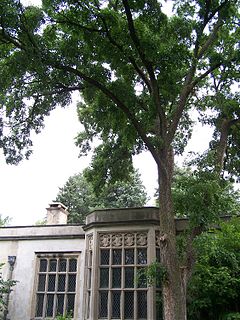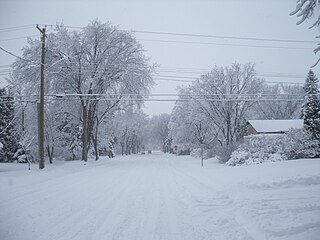Related Research Articles

Ulmus castaneifoliaHemsley, the chestnut-leafed elm or multinerved elm, is a small deciduous tree found across much of China in broadleaved forests at elevations of 500–1,600 metres (1,600–5,200 ft).

Ulmus szechuanicaFang, known as the Szechuan (Sichuan), or red-fruited, elm, is a small to medium deciduous Chinese tree found along the Yangtze river through the provinces of Sichuan, Jiangxi, Anhui, and Jiangsu.

Ulmus gausseniiW. C. Cheng, the Anhui, or hairy, elm, is a medium size deciduous tree whose natural range is restricted to the valleys of the Langya limestone mountains of Chu Xian in Anhui Province, eastern China. The tree was most commonly found on the flood plains, indicating a tolerance of periodic inundation. However, U. gaussenii is now possibly the rarest and most endangered elm species, with only approximately 30 trees known to survive in the wild in 2009.

Ulmus 'Morton' is an elm cultivar cloned from a putative intraspecific hybrid planted at the Morton Arboretum in 1924, which itself originated as seed collected from a tree at the Arnold Arboretum in Massachusetts. Although this tree was originally identified as Ulmus crassifolia, it is now believed to have been a hybrid of the Japanese elm and Wilson's elm. Accolade has proven to be the most successful cultivar tested in the US National Elm Trial, averaging a survival rate of 92.5% overall.
Ulmus 'Morton Plainsman' is a hybrid cultivar raised by the Morton Arboretum from a crossing of Siberian Elm and a Japanese Elm grown from openly pollinated seed donated by the Agriculture Canada Research Station at Morden, Manitoba. Tested in the US National Elm Trial coordinated by Colorado State University, Vanguard averaged a survival rate of 78% after 10 years.

Ulmus 'Morton Red Tip' is a hybrid cultivar raised by the Morton Arboretum from an open pollination of Ulmus 'Morton'. The tree has occasionally been reported as a hybrid of Accolade with the Siberian Elm Ulmus pumila, an error probably owing to the commercial propagation of the tree by grafting onto U. pumila rootstocks. Tested in the US National Elm Trial coordinated by Colorado State University, Danada Charm averaged a survival rate of 77.5% after 10 years.

Ulmus 'Morton Stalwart', is a Morton Arboretum hybrid cultivar arising from a controlled crossing of Accolade with the hybrid of a Field Elm U. minor from eastern Russia and a Siberian Elm U. pumila. Tested in the US National Elm Trial coordinated by Colorado State University, Commendation averaged a survival rate of 85% after 10 years.
The Chinese Elm cultivar Ulmus parvifolia 'Emer I' or 'Emerald Isle' was cloned from a tree planted circa 1920 on the University of Georgia campus at Athens.
The Chinese Elm cultivar Ulmus parvifolia 'Hallelujah' is one of three American introductions made circa 1992 that were selected for their cold hardiness. 'Hallelujah' is known to have withstood -37 °C (-35 °F) in Missouri.
Ulmus parvifolia 'Zettler' is a Chinese Elm cultivar that is one of three recent American introductions selected for their cold hardiness.
The Chinese Elm cultivar Ulmus parvifolia 'Matthew' is one of three American introductions selected for their cold hardiness.
The Chinese Elm cultivar Ulmus parvifolia 'Pathfinder' is another development by A. M. Townsend of the USDA National Arboretum registered in 1990.

The Chinese Elm cultivar Ulmus parvifolia 'King's Choice' is one of the early American selections best known for its winter hardiness, able to withstand temperatures of -30 deg. Celsius. 'King's Choice' was patented in 1985.
The Chinese Elm cultivar Ulmus parvifolia 'Glory' is one of the early American selections, best known for its winter hardiness.

The hybrid elm cultivar Ulmus × intermedia 'Lincoln' was selected from crossings of the Slippery, or Red, Elm Ulmus rubra and the Siberian Elm Ulmus pumila made in Aurora, Illinois, circa 1958 and patented in 1983 by Samuel Clegg of Clegg Landscaping, Plainfield, IL and Charles McFarland of Urbana, IL.

Ulmus 'Patriot' is a hybrid cultivar raised by the United States National Arboretum in 1980. Derived from a crossing of the American hybrid 'Urban' with the Wilson's Elm cultivar 'Prospector', 'Patriot' was released to commerce, free of patent restrictions, in 1993. Tested in the US National Elm Trial coordinated by Colorado State University, 'Patriot' averaged a survival rate of 85% after 10 years.

The American elm cultivar Ulmus americana 'Beaverlodge' was selected as a seedling in 1925 at the Beaverlodge Experimental Farm, Morden, Manitoba, part of the Lacombe Research Centre, Alberta, for its hardiness and vigour, and released in 1954.
The Chinese Elm cultivar Ulmus parvifolia 'Garden City Clone' was raised in Kansas. The champion tree was 18 m tall in 1993; however, the name 'Garden City Clone' is not officially recognized.
The Chinese elm cultivar Ulmus parvifolia 'The Thinker' was selected by M. Hayman from a tree on the campus of the University of Louisville, Kentucky.
The Chinese Elm cultivar Ulmus parvifolia 'Select 380' was tested in the United States for cold-hardiness. The name is considered invalid by some for want of fuller description.
References
- ↑ Lindstrom, O. M.; Dirr, M. A. (1991). "Cold hardiness of six cultivars of Chinese elm". HortScience. 26 (3): 290–2. INIST:5458797.
- ↑ "Elm Leaf Beetle Survey". Archived from the original on 2011-07-19. Retrieved 2017-07-17.[ full citation needed ]
- ↑ Santamour, Frank S.; Bentz, Susan E. (May 1995). "Updated checklist of elm (Ulmus) cultivars for use in North America". Journal of Arboriculture. 21 (3): 122–31.